
Posted on 07/01/2024 6:27:19 AM PDT by Red Badger

The position of a newly found dwarf galaxy (Virgo III) in the constellation Virgo (left) and its member stars (right; those circled in white). The member stars are concentrated inside the dashed line in the right panel
NAOJ/Tohoku University
==================================================================
For years, astronomers have worried about how to explain why the Milky Way has fewer satellite galaxies than the standard dark matter model predicts. This is called the “missing satellites problem.” In order to bring us closer to solving this problem, an international team of researchers used data from the Hyper Suprime-Cam (HSC) Subaru Strategic Program (SSP) to discover two completely new satellite galaxies.
These results were published in the Publications of the Astronomical Society of Japan on June 8, 2024 by a team of researchers from Japan, Taiwan, and America.
We live in a galaxy called The Milky Way, which has other, smaller galaxies orbiting it called satellite galaxies. Studying these satellite galaxies can help researchers unravel mysteries surrounding dark matter, and better understand how galaxies evolve over time.
“How many satellite galaxies does the Milky Way have? This has been an important question for astronomers for decades,” remarks Masahi Chiba, a professor at Tohoku University.

Satellite galaxies around the Milky Way Galaxy. The plane of the Galactic disk is on the horizontal plane. The blue squares are the Large and Small Magellanic Clouds, and the red circles are other satellite galaxies. The fainter their absolute visual magnitude, the smaller the dot size.
NAOJ/Tohoku University
================================================================
The research team recognized the possibility that there are likely many undiscovered, small satellite galaxies (dwarf galaxies) which are far away and difficult to detect. The powerful ability of the Subaru telescope – which sits atop an isolated mountain above the clouds in Hawaii – is well-suited to find these galaxies. In fact, this research team previously found three new dwarf galaxies using the Subaru telescope.

The area observed by the HSC-SSP (area surrounded by red lines). Previously known satellite galaxies are indicated by black squares, and newly discovered satellite galaxies are indicated by white triangles and stars.
NAOJ/Tohoku University
==================================================================
Now, the team has discovered an additional two new dwarf galaxies (Virgo III and Sextans II). With this discovery, a total of nine satellite galaxies have been found overall by different research teams. This is still much fewer than the 220 satellite galaxies predicted by the standard theory of dark matter.
However, the footprint of the HSC-SSP does not cover the entire Milky Way. If the distribution of those nine satellite galaxies across the entire Mily Way is similar to what was found in the footprint captured by the HSC-SSP, the research team calculates that there actually may be closer to 500 satellite galaxies. Now, we are faced with a "too many satellites problem," rather than a “missing satellites problem.”
To better characterize the actual amount of satellite galaxies, more high-resolution imaging and analysis is required. “The next step is to use a more powerful telescope that captures a wider view of the sky,” explains Chiba, “Next year, the Vera C. Rubin Observatory in Chile will be used to fulfill that purpose. I hope that many new satellite galaxies will be discovered.”
======================================================================
Published: 28 Jun 2024
Institution: Tohoku University Contact details: Public Relations Division Tohoku University Public Relations Division 2-1-1, Katahira, Aoba-ku, Sendai, 980-8577
public_relations@grp.tohoku.ac.jp +81-22-217-6038 Country: Japan Journal: Publication of the Astronomical Society of Japan News topics: Space Academic discipline: Space sciences Content type: Peer Reviewed Website: Too Many Missing Satellite Galaxies Found Reference:
Title:
Final results of the search for new Milky Way satellites in the Hyper Suprime-Cam Subaru Strategic Program survey: Discovery of two more candidates
Authors:
Daisuke Homma, Masashi Chiba, Yutaka Komiyama, Masayuki Tanaka, Sakurako Okamoto, Mikito Tanaka, Miho N. Ishigaki, Kohei Hayashi, Nobuo Arimoto, Robert H. Lupton, Michael A Strauss, Satoshi Miyazaki, Shiang-Yu Wang, Hitoshi Murayama
Journal:
Publication of the Astronomical Society of Japan
DOI: https://doi.org/10.1093/pasj/psae044
Once there were not enough satellite galaxies, now there are too many.
You just can’t please some people..............
Missing, then were found. Or, found to be missing. Very confusing title..

I think that they were right where God put them and it just took us this long to find them. Ok, now what.
They were never missing the egg heads were just looking in the wrong places.

or this

I had no idea that the Milky Way had so many satellite galaxies. I read a lot of astronomy books when I was in grade school, but all or most of them were written before artificial satellites or telescopes in space, so presumably our knowledge of other galaxies has increased exponentially since those books were written.
“She drove a Plymouth Satellite
A-faster than the speed of light...”
This problem caused me to lose astronomical amounts of sleep.
The most amazing thing is the generation of scientists, engineers, technicians, and bureaucrats who went from “hiring” to “retiring” phase of their lives during design and construction...
The same type of cycle is now underway for obtaining, processing, and writing up the data...
In addition, there is the next telescope cycle already underway that will carry careers from now until the 2040s...
“Don’t gimme no lines, and keep your hands to yourself...”
https://www.youtube.com/watch?v=WonOudGMSdc
Disclaimer: Opinions posted on Free Republic are those of the individual posters and do not necessarily represent the opinion of Free Republic or its management. All materials posted herein are protected by copyright law and the exemption for fair use of copyrighted works.